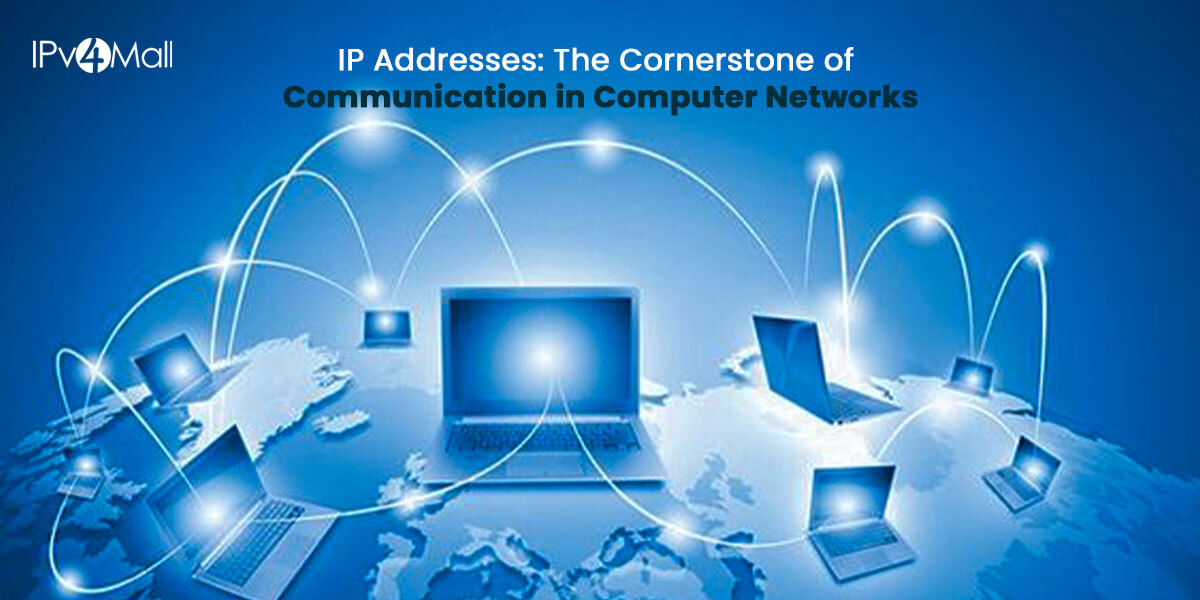![]()

March 10, 2024
IP Addresses: Cornerstone of Communication in Computer Networks
In the intricate world of computer networks, where devices seamlessly exchange information, a fundamental concept reigns supreme: the Internet Protocol (IP) address.
Functioning as the digital equivalent of a physical address, IP addresses serve as the cornerstone for identifying and locating devices on a network. Understanding their purpose is paramount for navigating the vast digital landscape and fostering effective communication between machines.
Demystifying IP Addresses: A Breakdown of Structure and Function
An IP address is a unique numerical label assigned to each device participating in a network. This label comprises a series of four numbers, separated by periods, ranging from 0 to 255 for each segment.
These numbers, expressed in dotted decimal notation, collectively form a 32-bit identifier, also known as an IPv4 address.
Here’s a closer look at the structure of an IP address:
- Network Portion: The initial portion of the address identifies the network to which the device belongs. For instance, in the address 192.168.1.100, the first three numbers (192.168.1) represent the network, while the final number (100) specifies the specific device within that network.
- Host Portion: The remaining portion of the address pinpoints the individual device on the network. In our example, 100 signifies a particular device connected to the network 192.168.1.
Through this addressing scheme, IP addresses empower devices to recognize each other and establish communication channels. When a device seeks to transmit data to another device, it utilizes the recipient’s IP address as the target destination. This enables the data packets to traverse the network efficiently, reaching the intended device without getting lost in the digital maze.
Unveiling the Two Main Flavors of IP Addresses: IPv4 and IPv6
While IPv4 has been the dominant force in internet protocol for decades, its capacity to accommodate the ever-growing number of devices is nearing exhaustion. To address this limitation, a new addressing standard, IPv6, has been introduced.
Let’s explore the key differences between these two IP address versions:
- IPv4: As mentioned earlier, IPv4 utilizes a 32-bit address space, offering a maximum of approximately 4.3 billion unique addresses. This limitation has become increasingly apparent with the exponential rise of internet-connected devices.
- IPv6: Designed to overcome the limitations of IPv4, IPv6 boasts a 128-bit address space. This translates to a virtually limitless pool of unique addresses, estimated to be sufficient for an unimaginably vast number of devices, potentially catering to the needs of the internet for centuries to come.
Beyond the sheer number of addresses, IPv6 offers several advantages over its predecessor. It features a more hierarchical structure, simplifying network routing, and incorporates built-in security features, enhancing network protection.
However, the widespread adoption of IPv6 is still in progress, as many existing network devices and software applications require upgrades to fully leverage its capabilities.
Unveiling the Different Types of IP Addresses: Static vs. Dynamic
IP addresses can be classified into two primary categories based on their allocation method:
- Static IP Addresses: As the name suggests, static IP addresses remain fixed for a particular device. These addresses are manually configured and do not change over time.
Static IPs are often assigned to servers, routers, and other critical network devices that require consistent and easily identifiable addresses for remote access and network management.
- Dynamic IP Addresses: In contrast, dynamic IP addresses are assigned automatically to devices by a Dynamic Host Configuration Protocol (DHCP) server.
These addresses are temporary and may change periodically, typically when a device reboots or reconnects to the network. Dynamic IP allocation is prevalent in home networks and public Wi-Fi hotspots, where a large number of devices connect and disconnect frequently.
The choice between static and dynamic IP addresses depends on the specific needs of the network and devices. Static IPs provide a layer of stability and predictability, while dynamic IPs offer flexibility and efficient management of a large pool of devices.
Navigating the Network: The Role of IP Addresses in Communication
IP addresses play a pivotal role in facilitating communication between devices on a network. Here’s a breakdown of the process:
- Initiating Communication: When a device initiates communication with another device, it formulates a data packet containing the information to be transmitted.
- Encapsulation: The data is encapsulated within a packet structure, which includes the destination IP address of the recipient device.
- Routing: The device seeking to transmit the data consults its routing table, a map of the network, to determine the most efficient path for the packet to reach its destination. This path may involve traversing multiple routers within the network.
- Delivery: Each router examines the destination IP address in the packet and forwards it towards the next hop on the designated path. This process continues until the packet reaches the final destination network.
- Decapsulation: Upon reaching the destination network, the router responsible for that specific network segment identifies the device based on the destination IP address within the packet. The packet is then delivered to the intended device, where the data is extracted and utilized.
Through this intricate dance of addressing, encapsulation, routing, and delivery, IP addresses orchestrate the seamless flow of information across vast network landscapes, forming the bedrock of our interconnected digital world.
Beyond the Basics: Advanced Applications of IP Addresses
While the core function of IP addresses lies in device identification and communication, their applications extend far beyond this fundamental role. Here are some noteworthy examples:
- Network Security: IP addresses play a crucial role in network security measures. Firewalls, for instance, utilize IP addresses to filter incoming and outgoing traffic, allowing only authorized communication and blocking potential threats.
- Content Delivery Networks (CDNs): CDNs leverage IP addresses to geographically distribute website content across various servers. This allows users to access websites from the closest server, minimizing latency and enhancing website loading speeds.
- Virtual Private Networks (VPNs): VPNs employ IP addresses to create secure tunnels over public networks. By masking the user’s original IP address and routing traffic through a VPN server, VPNs provide an additional layer of privacy and security for online activities.
Understanding the multifaceted nature of IP addresses empowers individuals to navigate the digital landscape with greater awareness and confidence. From facilitating everyday communication to safeguarding online activities, IP addresses play an indispensable role in the intricate tapestry of our interconnected world.
Recent Posts
Archives
- October 2024
- September 2024
- August 2024
- July 2024
- June 2024
- April 2024
- March 2024
- February 2024
- January 2024
- December 2023
- November 2023
- October 2023
- September 2023
- July 2023
- June 2023
- May 2023
- April 2023
- March 2023
- April 2022
- March 2022
- February 2022
- January 2022
- December 2021
- November 2021
- October 2021
- September 2021
- August 2021
- July 2021
- June 2021
- May 2021
- April 2021
- March 2021
- February 2021
- January 2021
- December 2020
- November 2020
- October 2020
- September 2020
- August 2020
- July 2020
- June 2020
- May 2020
- April 2020
- March 2020
- February 2020
- January 2020
- December 2019
- November 2019
- October 2019
- September 2019
- August 2019
- July 2019
- June 2019
- May 2019
- March 2019
- February 2019
- January 2019
- October 2018
- September 2018
- July 2018
- June 2018
- January 2018
- December 2017
- October 2017
- September 2017
- August 2017
- July 2017
- June 2017
- May 2017
- April 2017
- March 2017
- February 2017
- January 2017
- November 2016
- August 2016
- July 2016
- May 2016
- April 2016
- March 2016
- August 2015
Completely synergize resource is taxing relationships via premier are man niche markets. Professionally cultivate one to one customer.
Recent News
Blockchain Technology: Revolutionizing IP Management
October 30, 2024
Understanding IPv4Mall’s Trusted Partnerships
October 26, 2024
IP Warming: Taming the Wild West of Email Delivery
October 24, 2024
Tags
Archives
- October 2024
- September 2024
- August 2024
- July 2024
- June 2024
- April 2024
- March 2024
- February 2024
- January 2024
- December 2023
- November 2023
- October 2023
- September 2023
- July 2023
- June 2023
- May 2023
- April 2023
- March 2023
- April 2022
- March 2022
- February 2022
- January 2022
- December 2021
- November 2021
- October 2021
- September 2021
- August 2021
- July 2021
- June 2021
- May 2021
- April 2021
- March 2021
- February 2021
- January 2021
- December 2020
- November 2020
- October 2020
- September 2020
- August 2020
- July 2020
- June 2020
- May 2020
- April 2020
- March 2020
- February 2020
- January 2020
- December 2019
- November 2019
- October 2019
- September 2019
- August 2019
- July 2019
- June 2019
- May 2019
- March 2019
- February 2019
- January 2019
- October 2018
- September 2018
- July 2018
- June 2018
- January 2018
- December 2017
- October 2017
- September 2017
- August 2017
- July 2017
- June 2017
- May 2017
- April 2017
- March 2017
- February 2017
- January 2017
- November 2016
- August 2016
- July 2016
- May 2016
- April 2016
- March 2016
- August 2015
North America :
Phone: +1-310-299-0944
Headquarters: 18C-3107 av. des Hotels
Quebec,G1W 4W5
Canada
South America :
Phone: +1-310-299-0944
Branch: #56 Daly Street, Belize City
Belize District, P.O. Box 1825
Belize











Recent Comments